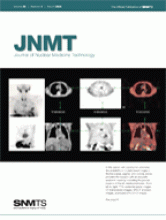Article Figures & Data
Tables
Radioisotope Main energy (keV) HVL of Pb (cm) 99mTc 140 ∼0.02 131I 364 ∼0.30 133Xe 81 ∼0.03 111In 245 ∼0.10 137Cs 662 ∼0.65 201Tl 70 ∼0.03 125I 35.5 ∼0.01 Data were obtained from online sources (4,5).
Health effects at following time after conception Acute radiation dose* to embryo or fetus Blastogenesis (up to 2 wk) Fetogenesis Organogenesis (2–7 wk) (8–15 wk) (16–25 wk) (26–38 wk) <0.05 Gy (5 rad)† Noncancer health effects NOT detectable Noncancer health effects NOT detectable Noncancer health effects NOT detectable Noncancer health effects NOT detectable Noncancer health effects NOT detectable 0.05–0.50 Gy (5–50 rad) Incidence of failure to implant may increase slightly, but surviving embryos will probably have no significant (noncancer) health effects Incidence of major malformations may increase slightly Growth retardation possible Noncancer health effects unlikely Noncancer health effects unlikely Growth retardation possible Reduction in IQ possible (up to 15 points, depending on dose) Incidence of severe mental retardation of up to 20%, depending on dose >0.50 Gy (50 rad)‡ Incidence of failure to implant will likely be large,§ depending on dose, but surviving embryos will probably have no significant (noncancer) health effects Incidence of miscarriage may increase, depending on dose Incidence of miscarriage probably will increase, depending on dose Incidence of miscarriage may increase, depending on dose Incidence of miscarriage and neonatal death will probably increase, depending on dose‖ Substantial risk of major malformations, such as neurologic and motor deficiencies Growth retardation likely Growth retardation possible, depending on dose Growth retardation likely Reduction in IQ possible (>15 points, depending on dose) Reduction in IQ possible, depending on dose Incidence of severe mental retardation of >20%, depending on dose Severe mental retardation possible, depending on dose Incidence of major malformations will probably increase Incidence of major malformations may increase ↵* Acute dose = dose delivered in short time (usually minutes). Fractionated or chronic doses = doses delivered over time. For fractionated or chronic doses, health effects on fetus may differ from what is depicted here.
↵† Both grays (Gy) and rads are units of absorbed dose and reflect amount of energy deposited into mass of tissue (1 Gy = 100 rad). In this document, absorbed dose is that dose received by entire fetus (whole-body fetal dose). Referenced absorbed doses in this document are assumed to be from β-radiation, γ-radiation, or x-ray radiation. Neutron or proton radiation produces many of health effects described here at lower absorbed doses.
↵‡ Expectant mother may experience acute radiation syndrome at this level, depending on her whole-body dose.
↵§ Fetal dose of 1 Gy (100 rad) will likely kill 50% of embryos. Dose necessary to kill 100% of human embryos or fetuses before 18 wk of gestation is about 5 Gy (500 rad).
↵‖ For adults, dose necessary to kill 50% of exposed population in 60 days is about 3–5 Gy (300–500 rad), and dose necessary to kill 100% of exposed population is about 10 Gy (1,000 rad).
Gestational age and radiation dose are important determinants of potential noncancer health effects. Following points are of particular note.
Before about 2 wk of gestation (i.e., time after conception), health effect of concern from exposure to greater than 0.1 Gy (10 rad) is death of embryo. If embryo survives, however, radiation-induced noncancer health effects are unlikely, no matter what radiation dose was. Because embryo is made up of only a few cells, damage to one cell, the progenitor of many other cells, can cause death of embryo, and blastocyst will fail to implant in uterus. Embryos that survive, however, will exhibit few congenital abnormalities.
In all stages of gestation, radiation-induced noncancer health effects are not detectable for fetal doses below about 0.05 Gy (5 rad). Most researchers agree that dose of less than 0.05 Gy (5 rad) represents no measurable noncancer risk to embryo or fetus at any stage of gestation. Research on rodents suggests that small risk may exist for malformations as well as effects on central nervous system in range of 0.05–0.10 Gy (5–10 rad) for some stages of gestation. However, practical threshold for congenital effects in human embryo or fetus is most likely 0.10–0.20 Gy (10–20 rad).
From about 16 wk of gestation to birth, radiation-induced noncancer health effects are unlikely below about 0.50 Gy (50 rad). Although some researchers have suggested small possibility of impaired brain function above 0.10 Gy (10 rad) at 16–25 wk of gestation, most researchers agree that after about 16 wk of gestation, threshold for congenital effects in human embryo or fetus is approximately 0.50–0.70 Gy (50–70 rad).
This table is intended only as a guide. Indicated doses and times after conception are approximations.







